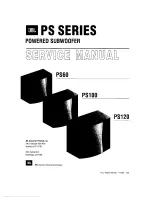
ASA80.2
1 - ArtSound
~220V,50Hz
OPERATIONS MANUAL
DESCRIPTION OF THE FEATURES AND CONTROL KEYS (FIG 1-2)
Power Switch: this three-mode switch controls the power status of the
subwoofer.
On - Turns the device on regardless of whether there is a signal or not.
Auto - Turns the device on when a line signal is detected.
Off - Turns off the device.
Status LED: this LED indicates the status of the device. “Red” indicates
that the device is connected to the mains and in standby mode. “Green”
indicates that the device is active.
Gain (volume control): this rotary button adjusts the volume of the sub-
woofer.
Crossover: this rotary button sets the upper frequency limit to which the
subwoofer plays. This can be adjusted according to the speakers used.
Line input: these RCA connections are suitable for a full range line signal
from the pre-amplifier output on a receiver or pre-amplifier.
Speaker-level input: these spring-loaded speaker terminals accept a
full-range stereo speaker-level signal from an already amplified output.
Speaker level output: these spring-loaded terminals are suitable for
looping through to your speakers.
Phase Control: this rotary button allows the subwoofer to be in phase with
the sound from other speakers. The result is a more cohesive sound.
Fuse
Power cord
ACTIF SUBWOOFER
Dear Customer, Congratulations on the purchase of your loudspeaker(s).
Please read these instructions carefully and keep them tor future reference.
SAFETY PRECAUTIONS
• Before connecting the equipment to the power outlet, first verify that the
mains voltage and frequency match the values specified on the equipment.
• If the power cord of the device is equipped with an earthing contact, then it
must be connected to an outlet with a protective ground. Never deactivate
the protective ground of a power cord.
• Unplug the power cord and power adapter from the power outlet if there is a
risk of a lightning strike or before extended periods of disuse.
• Replace fuses only with fuses of the same type and rating. If a fuse blows
repeatedly, please contact an authorized service company.
• Do not open or modify this equipment.
• After connecting the equipment, check all cables in order to prevent damage
or accidents, e.g., due to tripping hazards.
• Do not turn on the Amplifier ON before checking that all volumes to zero.
FIG 1
PLACEMENT OR POSITIONING
Your new subwoofer will work well in a variety of locations. However, place-
ment in your listening room will affect is performance. Because the sound you
hear is combination of direct sound from the speaker and reflected sound from
the wall, ceiling and floor of your listening room, placement of the subwoofer
in relation to room boundaries changes the balance of what you hear at low
frequencies. As a general rule, locating your subwoofer near the corner of the
room will increase its overall output. A middle of the room location would sug-
gest the smoothest response with the least output capability. Of course, any
location will be a compromise between acoustic performance and the aesthetic
blend of the subwoofer enclosure with the decor and furnishings of your room.
Don’t be afraid to experiment with the location of your subwoofer in your room
for the best results at your listening position. As with any other listening test, use
program material that you are familiar with that has substantial bass content.




















